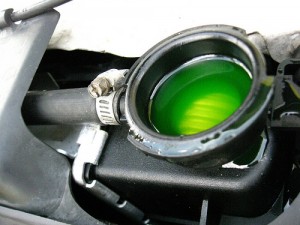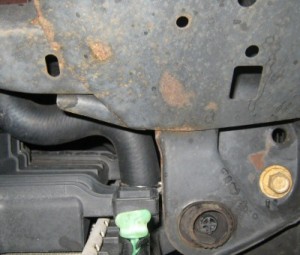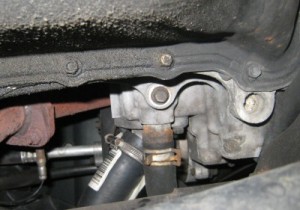
 This past weekend I was able to tackle a bunch of car maintenance and, with some expert help (thanks Chris), troubleshoot several problems.
This past weekend I was able to tackle a bunch of car maintenance and, with some expert help (thanks Chris), troubleshoot several problems.
My ’98 Saturn SL was in worse shape than I realized. Chris and I changed the oil, oil filter, air filter and coolant. We replaced both radiator hoses, spark plugs and wires and the muffler strap. Chris diagnosed and repaired my EGR valve (what the heck is that?!) and why my backup lights quit working- a bad switch.
Changing the oil, oil filter, air filter and even replacing brake pads are not difficult projects if you have the right tools. It turns out draining and replacing coolant is pretty straightforward too.
Selecting Coolant
Coolant, also called antifreeze, regulates the temperature of your engine. It prevents freeze-ups, overheating and boilovers.
 I purchased Prestone 50/50 antifreeze. It’s pre-diluted and can be added to all different makes and models. I like the convenience and often the pre-diluted options utilize deionized water- water that is physically processed to remove impurities and charged particles. Check the label and look for deionized water.
I purchased Prestone 50/50 antifreeze. It’s pre-diluted and can be added to all different makes and models. I like the convenience and often the pre-diluted options utilize deionized water- water that is physically processed to remove impurities and charged particles. Check the label and look for deionized water.
If you make your own antifreeze-water mix, pickup some distilled water. It’s not quite as “pure” as deionized water but is far better than using tap water.
I choose the universal option but your manual will specify which type / color coolant is suggested for your automobile.
Draining the Antifreeze
Draining the antifreeze is a simple process. Make sure you have a reservoir to catch several gallons of used antifreeze. Unscrew the reservoir cap so that it drains faster. Locate the antifreeze plug on the underside of your vehicle (green plug on second picture). Open the plug with pliers and let it drain.
This only removes about half the antifreeze. Next, you need to drain the engine block. Locate the appropriate plug and use a socket wrench to remove (center of third picture). Let the block drain completely.
Check your owners manual if you have a hard time locating these plugs.

Refilling the Antifreeze
Make sure you replace both plugs. Setup a funnel and begin replacing the antifreeze. Pour slowly to eliminate air bubbles and allow time for the coolant to fully permeate. Most antifreeze reservoirs have a fill line to indicate how much to add. I needed the better part of two gallons.
Once it looks full, start the vehicle and allow it to warm up. Keep the reservoir cap off. You may notice a few bubbles and the level dropping. Stop the vehicle and add coolant as needed.
What do you think? Any tips for changing coolant?
First image courtesy of Evelynishere







Make sure that you don’t mix coolant types. Often times, different types of coolant may be compatible with the same vehicle, but they are NOT always compatible with each other. Since this article is about completely draining and replacing the coolant, it’s not so much an issue. But for anyone adding to the reservoir without draining the block and radiator, always use the same type that’s already in there. My understanding is that to do otherwise could lead to corrosion issues.